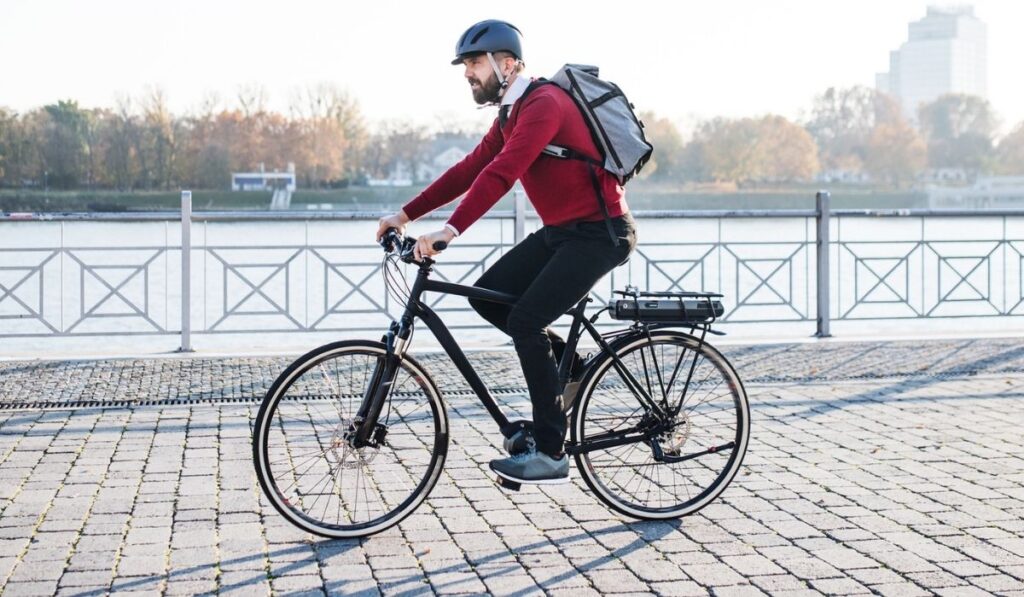Okay, so let’s say you’ve been eyeing an e-bike online for quite some time. You’ve got the color picked out, and your credit card in your hand. But a thought comes to mind: “am I making an environmentally sound choice?” It’s a common question for those of us attempting to live a more green lifestyle. Sure, an e-bike is a better choice than a car, but what are the real costs?
E-bikes are an amazing alternative transport if reducing carbon is on your mind. Not only do e-bikes emit less carbon per mile than cars, but they have many other eco-friendly benefits like having a recyclable battery and allowing users to cover more ground as opposed to traditional pushbikes while still getting some exercise.
So we know that reducing their carbon footprint is something a lot of people are focusing on these days. It may even be the reason you decided to get an e-bike in the first place. Read on to explore e-bikes and their environmental impact, and get more detail on the benefits of this wonderful transportation method.
Are E-Bikes Better for the Environment?

Conventional biking is a great way to get in some stellar exercise and reduce your carbon footprint. But what about e-bikes? These fancy motorized bikes come jam-packed with extra features that make your daily commute a little more relaxing, but does that extra convenience start to detract from the environmental benefits of traditional bikes?
E-bikes are great for the environment. While they do carry some cost in terms of carbon, compared to other forms of motorized transport (looking at you, cars), they overall provide riders a carbon-free way to get from one place to another. When we talk about environmental impact, there’s a lot more than just your daily commute.
To truly calculate the carbon costs of an e-bike, you need to consider what happens during the manufacturers and shipment of a product. Sure, you may not be putting carbon dioxide into the air when you pedal, but getting your bike to your doorstep certainly burns some fossil fuels. That’s exactly why you need to consider all factors before making a purchase.
That being said, e-bikes offer a wonderful way to cut down on your reliance on those fossil fuels that pump nasty contaminants into the atmosphere. In the end, we can only do our best to improve our planet; nobody’s perfect! But e-bikes give us a chance to reduce our reliance on the car, travel further than we would by using a regular bike and get healthy doing it.
Below you’ll find some of the best reasons why using an e-bike is great for you and the planet.
5 Environmental Benefits of Using an Electric Bike
Between eating locally, cutting out red meat, and moving away from single-use plastics, cutting out your car is by and large one of the most common practices to reduce your carbon footprint. Loads of people are ditching four wheels for two.
While this can be great, for some of us, all that pedaling can be a bit tiresome. Working hard at the pedals, getting sweaty, then having to head into work for eight hours sounds like a less-than-ideal morning routine. The e-bikes offer us the best of both worlds.
While e-bikes might not have the power of, say, a scooter, the battery power offers just enough juice to give us a little more range and a whole lot less sweat. So, if you’re thinking about buying an e-bike, what kind of environmental benefits should you expect?
Cut the Carbon for Your Daily Commute

Cars push out a ton of carbon. In fact, your average sedan puts around 500 grams of carbon into the air for every mile traveled. Add that up, and you can imagine why combustion engines for transport are one of the top contributors to carbon in our atmosphere. Using an e-bike, you can cut that down massively.
Sure, a regular old pushbike produces less Co2, but even then there are costs you probably haven’t considered. For example, with a regular bike, you burn more calories. This is great for the gut, but you’ve got to fill back up with energy at some point, and you’ll need to replenish all those extra calories you’ve just burned. The unfortunate fact is that many unavoidable everyday necessities also produce carbon.
This is exactly why the difference in grams of carbon between an e-bike and a regular bike is really rather minuscule. So while you might think there’s a huge difference between the two, you really aren’t adding much more carbon into the atmosphere when you opt for a motor instead of just pedal power!
Off-Peak Charging
One of the main criticisms of any electric-powered vehicle is the fact that the energy for the battery has to come from somewhere. This, of course, will depend on where you live. You might even have a solar rig at your home, but that’s a different story. For most of us, our electricity comes from a power plant that more than likely utilizes some sort of carbon-producing source.
As you can probably imagine, this isn’t great news for e-bike owners looking to cut carbon. In some areas, you might even be better off using a fuel-efficient car. But that all depends on how you are charging your battery. If you choose to charge during off-peak hours, you will put less demand on the power grid. This means you not only charge when your carbon emissions will be lower, but you will also save money.
The best part is that these hours are usually at night. If you happen to work a traditional 9-5 and charge your bike at night, you’re already doing your part. Keep in mind that you’ll need to do your own research to determine which time of day is best in your area.
Batteries are Improving
Here’s a basic fact about e-bikes: the bike is only as good as the battery. You might think that the motor plays the most important role, and while it does play a crucial one, your battery is definitely the most consequential element of your e-bike. It follows that you’ll want to find the best one for your bike, not just for usability but also for the environment.
Since battery quality is improving, this means you don’t need to charge it as often or for as long. The lithium-ion batteries that power most e-bikes are getting better with every passing year. This translates into better usability for your bike in terms of range and reliability, but also less carbon being put into the environment when it comes time to charge for the night.
Increased Riding Range
We partially already touched on this fact, but let’s drive it home. If you live more than, say, five miles from work, it means you’ll be dealing with quite the ride to and from the office every day. We’ve all got a co-worker that does it and, while commendable, there is no denying the sweat stains and tired eyes. E-bikes give riders the extra range they need to make it further distances while dealing with a bit less sweat and fatigue.
We can’t stress how important this is. Sure, it’s less of a tangible idea and more of a commentary on human motivation, but if your ride is easier, you’re more likely to opt for the e-bike than your car. This way, you reduce all that extra carbon you may have put into the atmosphere trying by taking the more convenient option of just driving.
Batteries are Recyclable
One of the main concerns with e-bikes is dealing with a dead battery. There is no way to sugarcoat it, but batteries are not good for the environment. Putting a lithium-ion battery in the trash is a no-go and illegal in most places.
When it comes time to discard an old battery, you may think that means you’re going to make an impact on the earth by disposing of the trash. Luckily, that’s not always the case.
Fortunately for you, lithium-ion is a finite resource. This means plenty of companies are working harder to get the material out of old batteries and back into the supply chain. You’ll need to find a special recycling center, but since these batteries are for more than just bikes, recycling of them is becoming more and more widespread.
